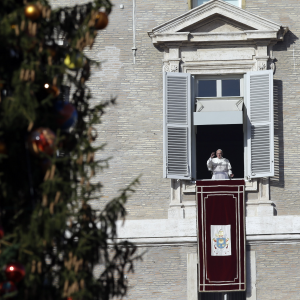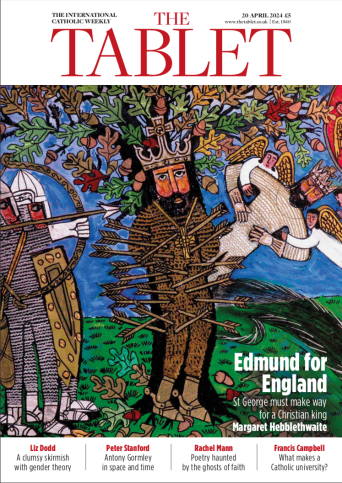Romans were expecting an invasion of pilgrims into the city at the start of the Pope’s Jubilee Year. While the city is decked out with lights, sparkling trees and a life-sized Nativity scene in St Peter’s Square, it appears most tourists coming to the city in December are here for a pre-Christmas shopping trip. There were just 70,000 at the Mass and opening of the Holy Door of St Peter’s.
This, however, is not going to worry the Pope too much. It seems his vision for the year is for local churches to take the initiative: to open their doors and put mercy into action.
In the same way he is decentralising mercy, Francis is keen to continue decentralising power in the Church.
After meeting with his Council of Cardinals last week, the Vatican announced that a special session on decentralisation and collegiality will be addressed at the council’s next meeting in February 2016.
It will be focusing on a speech the Pope gave to the Synod on the Family last October where he said that he wants to fulfil the wishes of the Second Vatican Council to implement collegiality by giving local bishops, and particularly bishops’ conferences, more authority.
This principle will also be applied in relation to his reform of the Roman Curia. Whatever new departments or structures are created, there is one overriding principle: the Pope wants Rome to have less power.
After Francis was elected, many were expecting a purge of the “old guard” appointed by Benedict XVI. Instead, a number of senior people have simply been left in their positions. And the word “left” is the operative word. In many cases, Francis has not replaced people but has instead allowed them to remain in posts that matter less and less. Cardinal Gerhard Müller, prefect of the Congregation for the Doctrine of the Faith, comes into this category.
Yet while the Pope is happy to see power moving away from the Vatican, he is keeping a tighter than ever grip on its finances. The decision to appoint PricewaterhouseCoopers (PwC) to audit the Holy See’s accounts should not be underestimated.
A spokesman for the company told me that the Italian branch of the firm will lead the task although it is likely that the team will be an international one.
It had better pick its most skilled operatives as PwC will be reliant on the financial information given by each Vatican department, organisations not used to rigorous standards of transparency.
Along with the auditors, Cardinal George Pell, effectively the Pope’s treasurer, has set up a working group to look at the future of the Vatican finances including income and expenditure. One of the things the group is keen to do is to include all assets in financial statements including St Peter’s Basilica, the Sistine Chapel and the art of Michelangelo. The work is far from complete.
Anyone wishing to describe the changes brought about by the Second Vatican Council ought to have the Church’s more positive relationship with Jews fairly high on their list.
Last Friday, the Vatican published a new document on the topic to mark 50 years since the council’s Nostra Aetate declaration. The new text said the Church does not support any “institutional mission” to the Jews, one of the delicate points of Christian-Jewish dialogue.
But if this is the case, why does the old rite of the Mass still include a Good Friday prayer titled “the conversion of the Jews”? In 2008, Benedict XVI rewrote the prayer for the Tridentine liturgy which asks God to “illuminate their hearts, that they acknowledge Jesus Christ is the Saviour of all men”.
Speaking at the new document’s launch, Cardinal Kurt Koch, president of the Pontifical Council for Promoting Christian Unity, admitted the title of the prayer was a problem but defended the content saying it must be understood eschatologically (a prayer for the end times).
Edward Kessler of the Woolf Institute, Cambridge, was less equivocal, describing the prayer as a “problem”.
During Pope Francis’ visit to Bangui, the capital of the Central African Republic, last month, a special peace pact between Christians and Muslims was put in place. The Community of Sant’Egidio, famous for its role in securing the Mozambique peace accord in 1992, helped broker the deal.
On the eve of the Pope’s visit to the country, the community also organised the first meeting with all the presidential candidates ahead of elections in the country on 27 December.
As a movement dedicated to peace and poverty, Sant’Egidio is very much in tune with this papacy and it appears Francis likes it (he recently named one member, Matteo Zuppi, as the Archbishop of Bologna, a see which normally comes with a red hat). For a Pope who distrusts parts of the Vatican, could Sant’Egidio operate a parallel papal diplomacy to that of the Holy See?
Christopher Lamb is Rome correspondent of The Tablet.
17 December 2015, The Tablet
Pilgrims to the Vatican this Christmas are choosing shopping over Mass
Edmund for England
 Loading ...
Loading ...
Get Instant Access
Subscribe to The Tablet for just £7.99
Subscribe today to take advantage of our introductory offers and enjoy 30 days' access for just £7.99





What do you think?
You can post as a subscriber user...
User Comments (0)